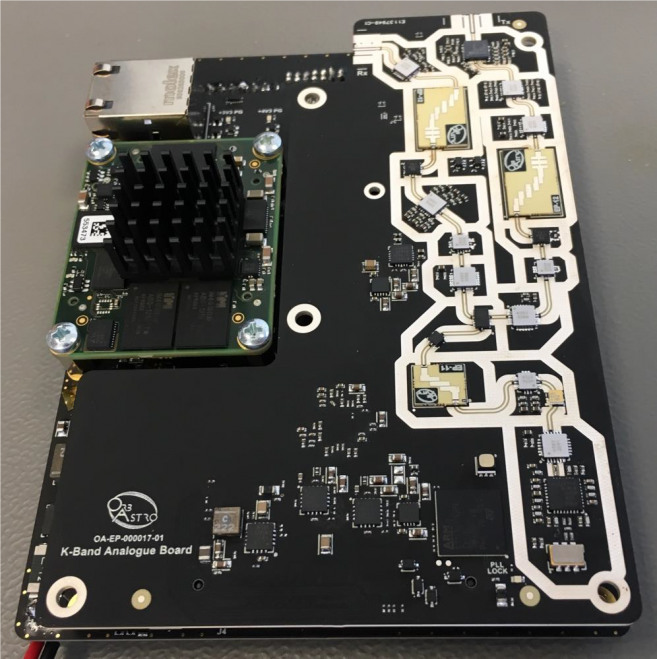
-
StatusCompleted
-
Status date2020-04-15
-
Activity Code6A.064
Objectives:
- Generate high-fidelity simulation tools to enable analysis of satellite formation flight.
- Using tools, refine and stress-test flock-level and system-level requirements for the associated Flocking Module to enable formation flight and autonomous flock management.
- Design, develop, and mature associated RF subsystem to EM level, for inter-satellite and ground communications.
- Carry out mission analyses to verify value added by Flocking Module to typical constellation and cluster missions for nanosatellites.

Figure 1. Breadboard of K-/Ka-band RF system subassembly (heat sink and EM shield removed)
Flock Management System
Consideration of flock-level performance for nanosatellite constellations / clusters is woefully lacking. Substantial improvements in mission-level efficiency are viable, translating many flawed aspirations into robust business cases. This typically manifests itself as:
- Fewer satellites required to perform a given mission
- Reduced launch mass
- Reduced mission operations overhead
- Extension of mission-lifetime
- Reduced latency with ground
- Broadening total addressable market
K-/Ka-band RF System
We have developed the lightest and most compact K-/Ka-band RF system in the market. Being SDR-based, it is highly flexible to customer requirements (modulation, error correction, etc.). Relevant to ground and inter-satellite communications. Configurable as a transmitter, receiver, and transceiver.
Flock Management System Key Features:
- Onboard component manifested as a small PCB based on the OrbAstro Telos OBC.
- Highly scalable (from several to several thousand satellites).
- Currently compatible with most constellation architectures and sparse cluster architectures.
- Highly flexible system, allowing customisation of autonomous mission-level performance optimisations.
- Fully autonomous flock deployment, formation maintenance, and de-orbit after decommissioning.
- Mature fault recognition of satellites within flock tightly coupled to autonomous flock management (based on deep FMECA, FTA, and associated analyses).
- Autonomous reconfiguration of flock to maximise relevant performance metrics and minimise disruptions associated with attrition over mission lifetime.
- Autonomous collision-risk detection/avoidance with local space traffic (satellites/debris). Traffic data collated from various sources (currently monitoring ~90k objects). Updated onboard every 4 hours, and continuously forward-propagated by 15 days.
K-/Ka-band RF System Key Features:
- Frequency Range: 22.0GHz – 30.0GHz (dependent on customer requirements)
- Data Rate: up to 100Mbps (dependent on range and antenna configuration)
- Volume: CubeSat-compatible, 0.3U
- Mass: 120g (system), 225g (system + EM shielding + heat sink)
Lifetime: 5 years
Completed.



